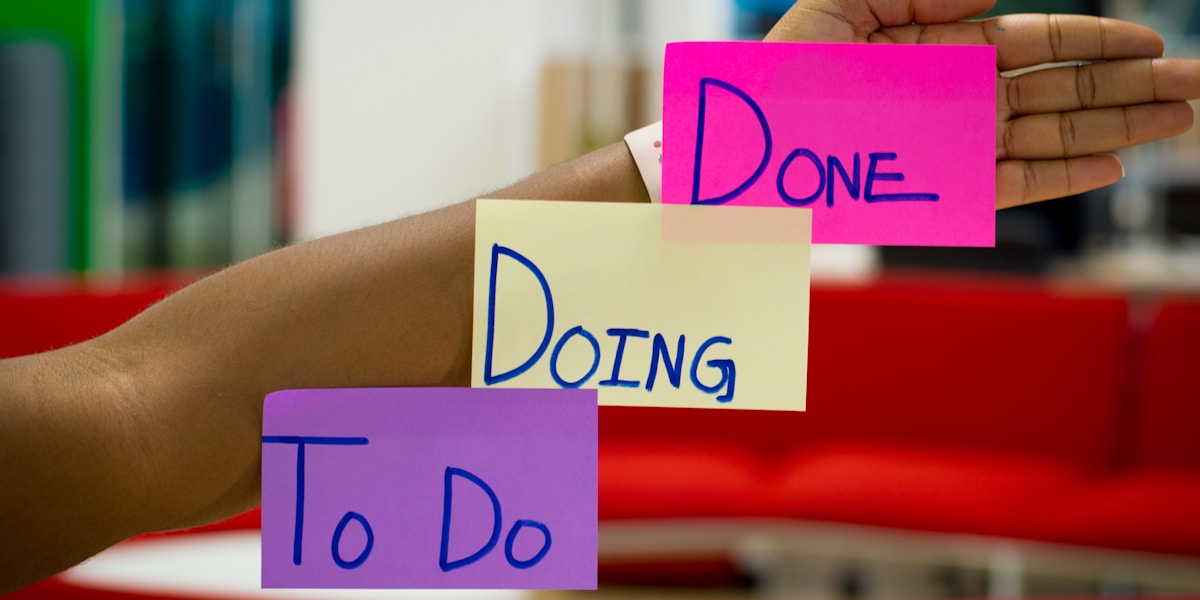Habit Tracker Tips for Improving Focus
Struggling with distractions? A habit tracker can be your secret weapon for building laser-sharp focus. Learn 5 proven strategies to train your attention.
Ever sit down to work, only to realize 30 minutes later you’ve answered three texts, checked your email twice, and somehow ended up scrolling through social media? You’re not alone. In today’s world, distractions are everywhere, and our attention spans are under constant attack.
The secret to cutting through the noise isn’t more willpower—it’s building better focus habits and tracking them consistently.
A habit tracker can become your best ally in sharpening focus, keeping you accountable, and training your brain to stick with deep work. Here’s how to use it effectively to transform your scattered attention into laser-like concentration.
The Science of Focus and Attention
Before diving into habit tracking strategies, it’s important to understand what’s happening in your brain when you lose focus.
Attention Residue: When you switch between tasks, part of your attention stays stuck on the previous task. This “residue” reduces your cognitive capacity for the current task.
Default Mode Network: Your brain has a “default mode” that activates during mental downtime—this is when your mind wanders. Focused habits help override this automatic wandering.
Neuroplasticity: Your brain physically changes based on repeated behaviors. Every time you practice focus, you’re literally rewiring your neural pathways to make concentration easier.
Why Focus Is Hard (and Why Habits Help)
Focus isn’t just about “trying harder.” Your brain follows patterns and seeks the path of least resistance. If you’re used to:
- Switching between apps every few minutes
- Multitasking during important work
- Constantly checking notifications
- Working without clear priorities
…these behaviors become your default habit loop, even when they work against your goals.
By deliberately building small focus habits—like turning off notifications, working in focused time blocks, or starting with 2 minutes of meditation—you retrain your brain to stay present and engaged.
The habit tracking advantage: Consistency is the key to rewiring your brain. A habit tracker ensures you practice your focus habits long enough for them to become automatic.
5 Habit Tracker Tips to Improve Focus
1. Start with One Focus Habit (The Single-Focus Rule)
The biggest mistake people make is trying to improve focus in multiple ways at once. This creates decision fatigue and often leads to giving up entirely.
Instead, pick ONE focus habit:
- “Phone-free work blocks” → Keep phone in another room during deep work
- “2-minute meditation” → Brief mindfulness before starting important tasks
- “Daily priority setting” → Identify top 3 tasks each morning
- “Notification shutdown” → Turn off all non-essential notifications during work hours
Track only this one habit until it becomes automatic (typically 21-30 days), then add another.
Why this works: Single-tasking your habit building mirrors the single-tasking you want to achieve in your work. You’re practicing focus by focusing on one habit at a time.
2. Use Visual Tracking to Stay Motivated
Every time you log a completed focus habit, you create a visual streak. This streak becomes psychologically powerful—research shows that visual progress tracking increases adherence by up to 40%.
The streak psychology:
- Day 1-7: Building initial momentum
- Day 8-21: Forming neural pathways
- Day 22+: Habit becomes more automatic than effortful
📱 Apps like HabitX make this process simple: mark an “X” when you complete your focus habit, and over time, those X’s turn into proof that your attention muscle is getting stronger.
Pro tip: Take a screenshot of your longest streak. Use it as your phone wallpaper for extra motivation.
3. Pair Focus Habits with Time-Blocking
Focus improves dramatically when you give tasks dedicated time blocks rather than working from an endless to-do list. Combine your habit tracker with time-blocking techniques:
Trackable time-blocking habits:
- “9-10 AM deep work block” → No email, social media, or meetings
- “Email batching” → Check email only at 11 AM and 4 PM
- “Phone airplane mode” → 2-hour morning focus block with phone off
- “Single-tab browsing” → Only one browser tab open at a time
Track both the habit AND the result: Note not just whether you completed the time block, but also what you accomplished. This creates positive reinforcement.
4. Reflect on Missed Days (Don’t Ignore Them)
A missed habit isn’t failure—it’s data. When you track consistently over weeks, patterns emerge that reveal your focus triggers and obstacles:
Questions to ask when you miss a focus habit:
- What was different about today?
- What time of day did I lose focus?
- What triggered the distraction?
- How was my energy level?
- What was my environment like?
Common patterns you might discover:
- Mondays are hard → Plan lighter focus work after weekends
- Afternoon energy crashes → Schedule deep work in the morning
- Open-plan office kills focus → Find quiet spaces or use noise-canceling headphones
- Social media breaks become hour-long spirals → Use app blockers during work time
Use these insights to adjust your environment and routines rather than relying on willpower alone.
5. Reward Your Streaks (Create Positive Reinforcement)
Staying focused is genuinely difficult in our distraction-rich world. Your brain needs positive reinforcement to continue choosing the harder path of sustained attention.
Streak reward system:
- 7 days: Treat yourself to a favorite coffee or snack
- 14 days: Buy a book or take a relaxing bath
- 30 days: Celebrate with a larger reward (dinner out, new productivity tool)
- 60+ days: Big celebration—you’ve officially rewired your focus habits!
Why rewards work: They activate your brain’s reward system, making the difficult work of building focus feel more pleasurable and sustainable.
Advanced Focus Tracking Strategies
Environment Design Tracking
Track habits that optimize your environment for focus:
- “Desk clearing” → Clean workspace before starting work
- “Phone distance” → Keep phone at least 6 feet away during deep work
- “Lighting optimization” → Use bright light during focus sessions
Energy-Based Focus Tracking
Match your focus habits to your natural energy patterns:
- Track your energy levels alongside your focus habits
- Identify your peak focus hours (often 2-4 hours after waking)
- Schedule demanding focus work during your biological prime time
Context-Specific Focus Habits
Create different focus habits for different contexts:
- Home focus routine: Meditation → phone in drawer → 90-minute work block
- Office focus routine: Noise-canceling headphones → calendar blocking → email batching
- Travel focus routine: Downloaded materials → airplane mode → single-task focus
Common Focus Habit Tracking Mistakes
Mistake #1: Tracking Too Many Habits ❌ Trying to improve focus, sleep, exercise, and diet simultaneously ✅ Focus on one attention-building habit until it’s automatic
Mistake #2: All-or-Nothing Thinking ❌ “I broke my streak, so I’ll start over next Monday” ✅ “I missed one day. Let me get back on track tomorrow.”
Mistake #3: Ignoring Context ❌ Same focus habits regardless of location, energy, or schedule ✅ Adapt habits to different contexts and energy levels
Mistake #4: No Environment Design ❌ Relying on willpower to ignore distractions ✅ Tracking habits that remove distractions from your environment
The Connection to Other Productivity Habits
Focus habits work best when combined with other productivity practices:
- Morning routines create a focused start to your day
- Daily planning gives your focus clear direction
- Overcoming procrastination eliminates avoidance behaviors that scatter attention
- Mindfulness practices strengthen your ability to notice when attention drifts
Frequently Asked Questions
How long does it take to improve focus with habit tracking?
Most people notice improvements in focus within 2-3 weeks of consistent habit tracking. Significant, lasting changes typically occur after 60-90 days of tracking focus habits.
Should I track multiple focus habits at once?
Start with one focus habit and track it consistently for at least 3 weeks. Once it becomes more automatic than effortful, you can add a second habit. Trying to track too many new habits simultaneously often leads to abandoning them all.
Can a habit tracker replace productivity tools?
A habit tracker complements productivity tools but doesn’t replace them. Think of it as building the discipline and consistency needed to use your other tools effectively. You might track the habit of “using time-blocking app daily” or “following Pomodoro technique.”
What if my focus habits aren’t working?
If you’re consistent with tracking but not seeing focus improvements, consider:
- Are you tracking the right habits? (Focus on environment design vs. willpower)
- Are your habits too ambitious? (Start smaller)
- Are you addressing the root cause of distractions?
- Do you need to change your physical environment?
How do I know if my focus is actually improving?
Track both the habit and the outcome:
- Time spent in deep work without interruptions
- Number of tasks completed during focus sessions
- Quality of work produced during focused time
- How often you notice your mind wandering (mindfulness improves with focus training)
Tools and Apps for Focus Habit Tracking
Habit Tracking Apps:
- HabitX → Simple, visual tracking perfect for building focus streaks
- Way of Life → Color-coded tracking for multiple daily habits
- Streaks → iOS-focused app with customizable habit tracking
Focus Enhancement Tools:
- Forest → Gamified focus sessions with virtual tree planting
- Freedom → Website and app blocker for distraction-free work
- RescueTime → Automatic tracking of how you spend time on devices
Time-Blocking Tools:
- Google Calendar → Free, simple time-blocking
- Clockify → Time tracking with project categorization
- Toggl → Detailed time tracking with focus session analysis
Start Your Focus Transformation Today
Improving focus isn’t about battling distractions with brute force—it’s about creating small, repeatable habits and tracking them until they become automatic.
A habit tracker turns focus from something abstract (“I need to concentrate better”) into something measurable, visible, and motivating (“I’ve maintained focused work blocks for 12 days straight”).
Your focus improvement action plan:
- Choose ONE focus habit to start with
- Track it daily using a simple system
- Reflect on patterns and missed days
- Adjust your approach based on what you learn
- Celebrate your streaks to maintain motivation
The difference between people with laser focus and those constantly distracted isn’t talent or willpower—it’s the daily practice of attention-building habits.
Ready to sharpen your focus and transform your attention? Download HabitX for iOS and start building your focus streaks today.
Turn scattered attention into sustained concentration—one habit, one day, one streak at a time.


